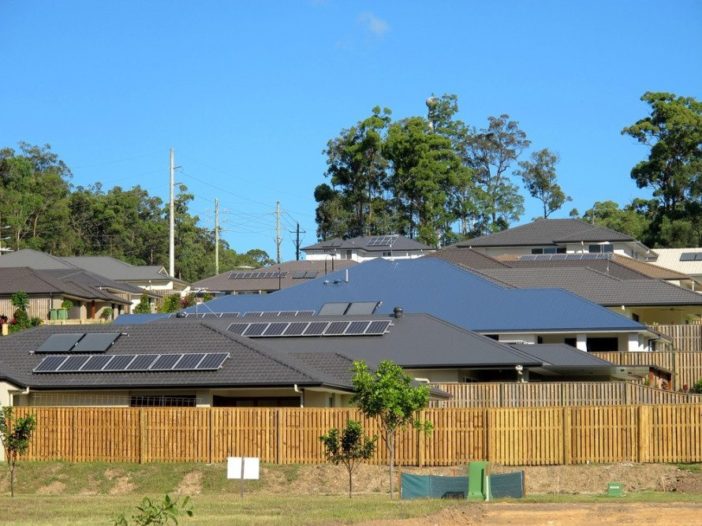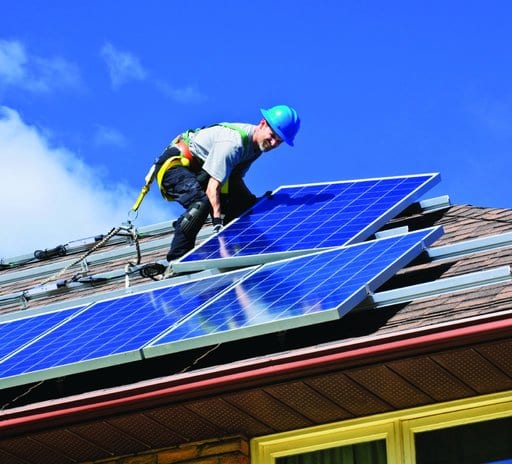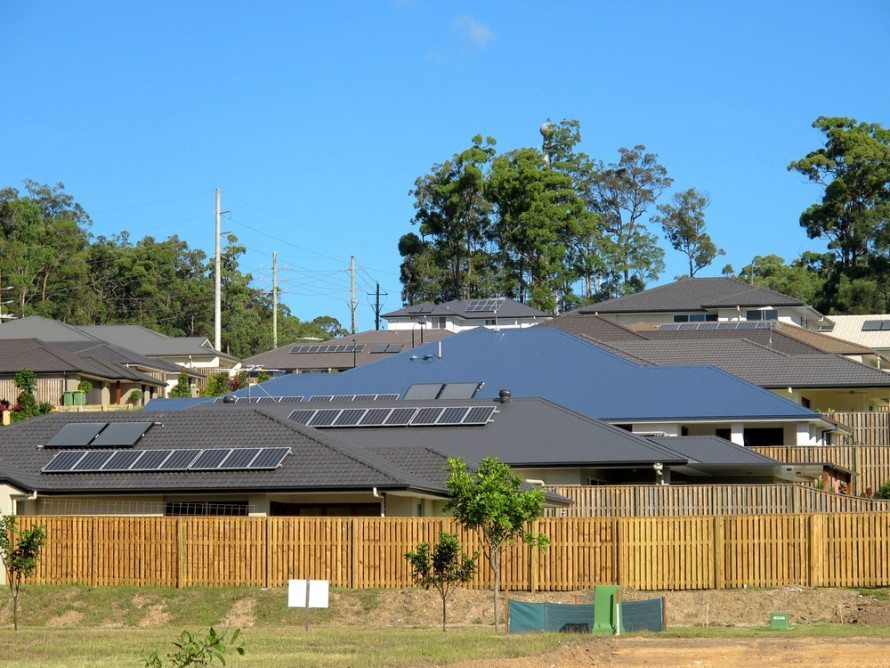

It appears the fossil fuel industry’s scare campaign over renewable energy driving up the price of electricity is having the same desired effect that it had back in 2011, when they campaigned against placing a penalty on polluting the atmosphere with global warming gases.
Yep you guessed it – households and businesses are flocking to install solar on their rooftops.
Green Energy Markets’ Solar Report assessment of STC creation data shows that March hit levels of capacity not seen since the days of 45c to 60c premium feed-in tariffs in 2011 and 2012, when there was also an STC rebate that was twice to five times its current level.
All up, we estimate almost 92MW (92,000 kilowatts) of rooftop solar PV capacity created certificates in March.
The chart below details the history of solar PV capacity installs since the beginning of the Small-scale Renewable Energy Scheme. I’ve added a green dashed line providing a 6 month moving average to try to illustrate longer term trends, with the yellow line representing actuals.
National solar PV capacity creating STCs by month of creation – Feb 2011 to March 2017

The chart clearly shows the surge in sales around mid-year in 2011 and 2012 as households rushed in before STC rebate multipliers stepped down, as well as the loss of the Queensland premium feed-in tariff. Since those heady days of high government support though it’s been a steady decline.
Things for the rooftop solar sector looked particularly grim at the beginning of last year. January 2016 was a shocker (partly symptomatic of Christmas holidays) which was followed by a weak February and March.
It was the worst quarter we’d seen over the history of the Small-Scale Renewable Energy Scheme, barring the very first quarter when the SRES first began in 2011.
Capacity then recovered in the 2nd and 3rd quarters of 2016 but still at levels clearly down on 2014. At this point we thought maybe the market has bottomed and had managed to reach a steady state of about 60,000kW per month.
Then in November and December the market took off reaching levels of capacity similar to 2013 levels. They held up well in January too, with 65.5MW registered for STCs, which was higher than every other month of 2016 bar November and December, and 11% above the 2015 monthly average – quite exceptional given the holiday period.
At the time we put this down to the well-worn sales technique the solar industry has employed in the past to get wavering customers to sign the dotted line. This is the threat to get in now before the government pulls down the rebate. While the STC rebate was only dropping by not much more than $50 per kilowatt, sometimes customers don’t analyse these things rationally.
Then February recorded more capacity than November. And now March capacity has shot 16 per cent higher than December.
This has got us thinking at Green Energy Markets that more fundamental and longer term drivers are potentially supporting this increased capacity.
- Wholesale power prices doubling
First and foremost contract prices for wholesale power have reached extraordinary levels and these are flowing through to rises in retail electricity prices. 2018 baseload forward contracts are trading at about $100 or more – almost twice the levels when the carbon price was in place.
Power contract prices for next year are now far higher than wholesale spot prices during carbon price period

This is being felt most acutely by business customers, who pay separate fees for their energy consumption from network charges. Our analysis finds that the commercial sector (which we define at 10kW of bigger systems) is now a very big part of the solar market.
Back in July 2013 commercial systems made up 10% of the market by capacity. In December 2016 they were 30% and in March 2017 they were 28%. We are hearing of business customers seeing their energy charges for new contracts doubling to prices close to 20 cents per kilowatt-hour. Solar represents an incredibly compelling financial proposition at these kinds of prices for energy from the grid.
Ofcourse these higher wholesale power costs are also flowing through to residential consumers but they shouldn’t be generating the same kind of bill shock that we saw back in 2008-2012 driven largely by the Australian Energy Market Commission granting network monopolies a license to print money.
- The scare campaign that renewable energy is destroying the world
You could call this the Daily Terrorgraph effect – essentially the tabloids across Australia have discovered that stories alarming readers that the cost of just about everything is going through the roof help sell newspapers. Or at the very least earn tidy commissions via One Big Switch campaigns.
Also, suggestions the lights are about to go out for a third of the year also work well in capturing eyeballs.
While power price rises are undoubtedly real, in reality their impact on household budgets are not nearly as bad as the wall to wall coverage of our tabloids might suggest. Also, the suggestion that the grid will melt down sending the lights out for a third of the year if we add just one more wind or solar farm is manifestly stupid.
But it seems such media coverage, irrespective of how poorly researched it might be, gets both households and business people very anxious, just like it did when the carbon price was under consideration. It also helps if you have politicians spreading fear about power bills and reliability.
But it doesn’t quite work out the way the fossil fuel industry that dreamed up the PR campaign intended. Households and businesses start worrying and think I need to take things into my own hands – and that happens to mean a solar system.
- Batteries, electric cars and the emergence of the technophile market segment
This might be called the Tesla effect. Batteries and electric cars still don’t quite represent a readily affordable or compelling financial proposition for many households or businesses. But they really like the idea of ultimately owning what they perceive to be a really cool piece of technological kit. At present our evidence is only anecdotal, but we suspect the hype and excitement about batteries is driving customer enquiries to solar businesses.
In the end these customers are baulking at laying down the cash just yet for the battery. But they think I can afford solar now as the first step, and later on when batteries and electric cars become cheaper I’ll get them too.
We would warn readers that before they get too excited, that it’s still early days. We can’t be sure the high levels of capacity seen from November until March are here to stay. But is starting to look very interesting.
Tristan Edis is Director – Analysis & Advisory with Green Energy Markets. Green Energy Markets assists clients make informed investment, trading and policy decisions in the areas of clean energy and carbon abatement. Follow on Twitter: @TristanEdis

